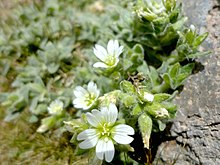en
names in breadcrumbs


Cerastium is a genus of annual, winter annual, or perennial flowering plants belonging to the family Caryophyllaceae. They are commonly called mouse-ears or mouse-ear chickweeds. There are 214 accepted species,[1][2] found nearly worldwide but with the greatest concentration in the northern temperate regions. A number of the species are common weeds in fields and on disturbed ground.
Cerastium species are used as food plants by the larvae of some Lepidoptera species including Coleophora chalcogrammella (which feeds exclusively on Cerastium arvense) and Coleophora striatipennella (which has been recorded on Cerastium fontanum).
Cerastium is a genus of annual, winter annual, or perennial flowering plants belonging to the family Caryophyllaceae. They are commonly called mouse-ears or mouse-ear chickweeds. There are 214 accepted species, found nearly worldwide but with the greatest concentration in the northern temperate regions. A number of the species are common weeds in fields and on disturbed ground.
 Cerastium uniflorum
Cerastium uniflorum  Cerastium tolucense
Cerastium tolucense Cerastium species are used as food plants by the larvae of some Lepidoptera species including Coleophora chalcogrammella (which feeds exclusively on Cerastium arvense) and Coleophora striatipennella (which has been recorded on Cerastium fontanum).